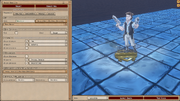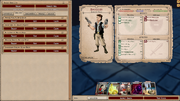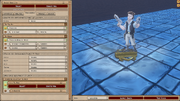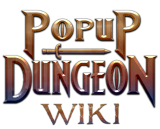
"Who's scruffy lookin'?" The smuggler will be our test subject for enemy creation.
Enemy creation allows you to create entities to fight, summon or transform into. It is often a bit simpler than hero creation (LINK), because you need no equipment, the visuals can be normal images and the number of required sounds is a bit smaller. Unlike heroes, enemies do not increase their power by equipping better items, instead they just gain additional base power by ranking up - making their stats completely predictable. This tutorial will cover all important parts to create an entity ready for battle and also explain the different roles and skins used by all enemies.
Creating an enemy
What do I want?
First of all, a few thoughts about what kind of enemy you want to create and how it will be used in the game can simplify the whole process. Do you want to make a story-driven villain, a ruthless hero-killing machine, a summoned totem or a transformation for your hero? Do you already have abilities prepared or will you create them as you go?
A few tips to simplify and maximize the effect of your creations:
- Unlike heroes, enemies can have multiple major/normal/minor strengths and weaknesses (gaining them at higher ranks) allowing for additional complexity as they rank up. It also allows to pick the same strengths multiple times to create very dedicated builds.
- Enemies that are only made for summoning can often get abilities with limited uses without worries. Immobile summons are also predestined fora major mobility weakness - if they are only to act as walls, you can reduce initiative and speed as well.
- Building on top the pre-defined roles and skins can save a lot of time, but if you want minimum preset parameters, use the Skirmisher role and no skin.
- If you define your enemy first and create its abilities afterwards, you can directly preview their power - remember to test them out for different power ranks as well. On the other hand, if you already have abilities prepared (especially those with status effects or statistical conditions) be careful when assigning these abilities to a certain rank - maybe your novice werewolf is just not ready to pass a [>100 power] check yet...
- At last: Don't worry about forgetting crucial stats for the boss-form of your creation (if you intend to use it as an enemy). The game will automatically add a resistance & health strength at the legendary rank (of course, you can try to counter this by adding weaknesses, but otherwise, the game will ensure that a boss is not that easy to stun, charm or kill).
The Statistics Tab
First of all, your new creation will need a name and possibly unique names based on rank. You can add a unique name for each rank, which will overwrite the entity's name during combat and they are automatically used as tags to search for your enemy.
Celestial Supporter or Clockwork Berserker? - The right Skins & Roles
Next up comes the role and (optionally) skin selection, which will set some basic strengths and weaknesses for your enemy, making it easier for players to know what they're up against. The smuggler for example, is simply a rogue which means he has increased back power, critical chance, speed, health and armor penetration, but reduced support. You can play around with some other roles or apply a skin to see how his stats change - you could make him a watchful rogue and increase his back and flank defense (at the cost of the other statistics of course).
You can find a complete list of all strengths and weaknesses set by these at the end of the article.
Fleshing out the details - Strengths & weaknesses
Similar to hero creation (LINK), you can also choose up to 3 additional strengths and weaknesses to further tune your creation to your liking. Our unshaven friend has increased aim for example because he only relies on ranged attacks while his deficient back defense is somewhat compensated by his reactive [Shoot First] which turns him towards any potential attacker. You can also choose one additional strength or weakness for each rank, with the option to set it as active at only this specific rank (for example, a novice fighter could lack initiative). It is important to remember that the strengths and weaknesses will increase with the entity's base power and thus by rank: A legendary marksman has an automatic mobility weakness, rendering it immobile at legendary if not accounted for! Experimenting with the different settings and their consequences might take some time, but it will also lead to much more satisfying results.
Executing orders - About the A.I. settings
At last, you can set a general A.I. behavior, choosing how aggressive (attacking enemies or staying away from them) and supportive (using friendly abilities on oneself or other allies) your creation shall be. For most cases, the standard settings will probably suffice (and you don't have to consider them at all if you're only creating a player-controlled or passive entity).

Our legendary rogue is a good example of growing complexity and building up a combo: His back shot is hard to trigger at first, but combining it with [What's that?] allows him to set the stage perfectly. At last, his [Cheap Shot] reaction can trigger as well when turning an enemy away, thus combining three abilities into a devastating attack combo.
The Abilities Tab
Next up is choosing some nice abilities that your enemy will feature - you can select up to five abilities, one earned at every new rank by your creation. If you leave an empty slot, the system will automatically duplicate one of the lower ranked abilities. Unlike with heroes, the abilities' rank will automatically rise: An elite werewolf will therefore have three master-level abilities. The most important part here is probably gifting abilities in a logical order, which not only increases the possibilities of your creation, but also allows for more interesting combos.
Don't do that! - Helping the A.I. getting it right
Sometimes, especially when building a story-driven enemy, the A.I. might use abilities combining positives and negatives in an unintended way - for example using a defense-up with mobility-down on an enemy instead of a fragile ally. Or attacking an enemy before using defense-lowering debuffs first. In this case, it might be necessary to make their abilities a bit more complex using conditions or reactions with to make sure they work as intended. Using allegiance conditions can ensure the right target, while commands (reactions that can trigger during your turn) can make sure the entity is forced to use a certain ability if possible. Otherwise you can try changing the A.I. settings, especially aggression, for a more satisfying experience.

The smuggler is only encountered in the Starship tileset and especially often in the transporter and cargo room. He can appear with the same rate at any given rank and has an preferred drop - the Blaster.
The Encounters Tab
Here I am - Setting the appearance chance
In this tab, you can define where and how often your creation can appear as an enemy. You can either use a global appearance rate (for every tile- and subset), go by general layout (Starship, Dungeon, Forest Village, Giga city, Haunted House, Japanese, Steampunk, or Post Apocalyptic) or by room (e.g. the Starship bridge). A more detailed setting will override any previous setting: Room > Tileset > Global. For example, the smuggler has a slightly higher appearance chance in the transporter and cargo room of the Starship tileset, a normal rate in the Starship in general and no global appearance (to prevent him from spawning normally anywhere else, like the haunted house).
A boon at last - Dropping equipment
Any enemy can drop your hero's preferred equipment and some tileset-specific things, but you can also set a piece of equipment that is dropped preferred (or only) by your creation. You can choose as much pieces of equipment as you like, they will all have a higher-than-usual drop chance (but you cannot select the same piece multiple times, it is always the same chance for all pieces of equipment).
The Visuals Tab
Look at me - Basic Appearance
Enemy visuals are a bit easier to create than for heroes, because most pictures can be imported and used right away! PUD features an auto-cut mode to remove unnecessary backgrounds or just accepts any image with transparency as is (Gimp might be a useful tool for this). You can also choose one of eight animation styles for your creation, ranging from just standing still to a shambling zombie (of course, this doesn't affect the entity's performance in any way). Next up, you can scale the selected image within certain limits and even set a different height to display for each rank - usually boss enemies tend to be larger, but you can choose freely.
Hit where it hurts - Body part positions
The body part positions are an optional, but very useful setting to complete your creation and help the media system target the right parts of the image supplied. You can specify the points for primary and secondary equipment, the head, chest and groin area, hands and feet - which are all used as part of the media and particle creation system (LINK). Usually, the equipment is the most important part, as most attack animations make use of them, but head and chest might we useful as well. You can play around with the smuggler's primary equipment for example and head over to ability creation and check out his new animation (automatically creating a new copy when saving).
Talk to me - Dialogue representation
The very last and often overlooked part is only important if you plan on using your creation for a custom game (LINK): The dialogue representation let's you choose different speaker images and sounds based on emotion and an standard audio for the sound made when writing his speech text. This is only of importance, if the enemy's image is to be replaced or if you need several different mood representations, otherwise you can use any enemy's image as a speak in game creation.
The Sounds Tab
At last, you can select or create a set of sounds used by your new creation. You can import soundtracks of up to 5 second length and use them for more or less specific actions (like a general grunt that might play when hit or using an ability or a a few lines to say at the start of each turn) or just select an existing one from the game library. You can also specifiy the relative rate these sounds are used and change pitch and speed of the entity based on its rank.
A good wavelength - Tips for sounds
Keeping it short is often advised, as a lot of sounds might overlap, for example the turn start and move action will often play together, because the A.I. might start moving while the turn start sound still plays. Also, hit, critically hit and death sounds might play at the same time. If you notice that a sound is too long, you can directly cut it in-game and also apply fade-in or -out effects right after importing.
Useful Details
Table of Roles and Skins
| Role | Minor Strength | Strength | Major Strength | Minor Weakness | Weakness | Major Weakness |
|---|---|---|---|---|---|---|
| Berserker | Health,Speed | Haste, AP, CC, | Evasion, Support | |||
| Brute | Stability | Health | Power | Initiative, Mobility | Cover | |
| Caster | Health, Power | Aim | Focus | Defense | ||
| Duelist | Front Power | Health, Speed | Haste | Back Power | ||
| Fighter | Mobility | Health, Speed | AP | Aim | ||
| Fury | Health, Power, Mobility | Focus | Aim | |||
| Guardian | Resistance | Support | Health, Defense | Mobility, AP | ||
| Manipulator | Health, Resistance | AP | Support | |||
| Marksman | AP | Aim | Mobility, Defense | |||
| Ravager | Healing Rec, AP | Health | Life Siphon | Defense | ||
| Rogue | Health, AP | Crit Chance, Speed | Back Power | Support | ||
| Skrimisher | Speed, Power, Defense, Health | |||||
| Support | Health, Status Def | Aim | Support | AP | ||
| Skin | Minor Strength | Strength | Major Strength | Minor Weakness | Weakness | Major Weakness |
| Elemental | Elemental Defense | |||||
| Enchanted | Magical Defense | Mundane Defense | ||||
| Martial | Physical Defense | |||||
| Metaphysical | Energy Defense | |||||
| Shielded | Front Defense | Back Defense | ||||
| Tough | Mundane Defense | Magical Defense | ||||
| Clumsy | Evasion | |||||
| Distracted | Flank Power | Reflexes | Back Defense | |||
| Exposed | Cover | |||||
| Fragile | Physical Defense | |||||
| Meager | Reflexes | Health, Stability | ||||
| Poorly Insulated | Elemental Defense | |||||
| Sickly | Health | Healing Rec | ||||
| Tasty | Damage Reflect | |||||
| Vulnerable | Defense, Evasion | |||||
| Weak Willed | Energy Defense | |||||
| Yielding | Stability | Resistance | Status Defense | |||
| Aerial | Air Defense | Earth Defense | ||||
| Aquatic | Water Defense | Air Defense | ||||
| Burly | Body Defense | Power | ||||
| Dark | Dark Defense | Light | ||||
| Earthen | Earth Defense | Air Defense | ||||
| Faithful | Spirit Defense | Mind Defense | ||||
| Fiery | Fire Defense | Water Defense | ||||
| Leathery | Slashing Defense | Body Defense | ||||
| Luminous | Light Defense | Dark Defense | ||||
| Plated | Blunt Defense | Piercing Defense | ||||
| Porous | Piercing Defense | Blunt Defense | ||||
| Psychic | Mind Defense | Spirit Defense | ||||
| Beastman | Mundane Defense | Status Defense | Elemental Def | Mind Defense | ||
| Botanical | Water Defense | Earth Defense | Slashing Defense | Fire Defense | ||
| Celestial | Spirit Def, Air Def | Light Defense | Stability | Cover | Dark Defense | |
| Clockwork | Physical Defense | Mind Defense | Water Def | Earth Def | ||
| Construct | Resistance | Body Defense, Mundane Def | Reflexes | Magical Defense | ||
| Cursed | Defense | Health | Life Siphon | Evasion | ||
| Draconic | Health, Fire Defense | Resistance | Body Defense | Piercing Defense | ||
| Fey | Evasion | Reflexes, Mag Def, Elemental Def | Mundane Defense | Energy Defense | ||
| Fiendish | Damage Reflect, Fire Def, Dark Def | Water Def, Spirit Def | Light Defense | |||
| Frozen | Water Defense | Blunt Defense | Fire Defense | |||
| Hot Headed | Speed | Taunt Defense | ||||
| Insectoid | Reflexes, Cover, Evasion | Earth Defense | Stability | Physical Defense | ||
| Jumpy | Reflexes | Back Defense | Front Defense | Fear Defense | ||
| Monstrous | Defense, Health | Slashing Defense, Status Def, Spirit Def | ||||
| Mutant | Disable Defense | Reflexes, Healing Rec | Defense | Elemental Defense | ||
| Mythical | Spirit Defense, Stun Defense | Magical Defense | Mundane Defense | Physical Defense | ||
| Radioactive | Reflexes, Energy Defense | Damage Reflect | Cover | Physical Defense | Dark Defense | |
| Robotic | Resistance, Physical Defense | Evasion | Elemental Defense | |||
| Skeletal | Dark Defense | Cover, Piercing Defense | Light Defense, Blunt Defense | Healing Rec | ||
| Spectral | Evasion, Physical Defense | Health | Stability | Magical Defense | ||
| Steamy | Damage Reflect | Fire Defense | Water Defense | Air Defense | ||
| Undead | Physical Defense, Dark Defense | Fire Defense, Light Defense | Healing Rec | |||
| Vampiric | Life Siphon, Dark Defense | Piercing Defense, Earth Defense | LightDefense | |||
| Armored | Stability | Defense | Mobility | |||
| Entrenched | Cover | Reflexes | ||||
| Evasive | Evasion | |||||
| Graceful | Reflexes | Evasion | Defense | Stability | ||
| Healthy | Healing Rec | Health | ||||
| Hulking | Health | Cover, Reflexes | ||||
| Illusive | Cover | Reflexes | ||||
| Pacifist | Evasion | Life Siphon | ||||
| Skittering | Cover, Evasion | Health, Defense | Reflexes, Stability | |||
| Thorned | Health | Damage Reflect | ||||
| Unyielding | Stability | Status Defense | Resistance | |||
| Watchful | Back Defense | Flank Defense | ||||
